Rules for Horizontal Holes
Number of holes per span for TJI® Products
The following limitations are for individual spans. There is no cap to the number of holes allowed for the entire length of a multi-span TJI® member. Software determines the hole size relative to the depth of the joist and this size is shown in the member report.
| Hole Size Group | Limitation of number of holes per span |
|---|---|
|
(Ignore) |
No limit for circular holes less than or equal to 1.5" in diameter and rectangular and slotted holes with both width and height less than or equal to 1". These holes are not analyzed. They are however, subject to hole-to-hole proximity checks. |
|
Small (S) |
No limit except when combined with Extra Large Holes. The presence of small holes may limit the number of larger hole sizes. |
|
Medium (M) |
5 per span only if there are no other size groups present. 4 per span when combined with Small and/or Large holes. |
|
Large (L) |
3 per span only if there are no other size groups present. 2 per span when combined with Small and/or Medium holes. |
|
Extra Large (XL) |
2 per span + 1 Small hole or 1 Medium hole. |
Number of circular holes per span for TimberStrand®, Microllam®, and Parallam®
The following limitations are for individual spans. There is no cap to the number of holes allowed for the entire length of a multi-span SCL member.
| Hole Size Group | Criteria for hole size | Limitation of number of holes per span and effect in MOE |
|---|---|---|
|
Per Lit. |
Hole meets size and conditions listed in our prescriptive hole literature |
No limits to number of holes No effect in MOE |
|
Small (S) |
Hole diameter ≤ 1/3 product depth |
No limits to number of holes No effect in MOE |
|
Large (L) |
1/3 product depth < hole diameter ≤ 2/3 product depth |
3 per span regardless of how many small holes may be present 9% reduction in MOE if 3 large holes 5% reduction in MOE if less than 3 large holes |
|
Extra Large (XL) |
Hole diameter > 2/3 product depth |
Will not be designed |
Prescriptive SCL circular hole rules are covered in our literature. See TJ-9000 and TJ-9020 for the U.S, and TJ-9500 and TJ-9050 specifier’s guides for Canada found in the Weyerhaeuser® Document Library.
Proximity rules for web holes in TJI Products
ForteWEB® software enforces the following rules concerning TJI® web hole proximity to supports, to other holes, and to the end of the member:
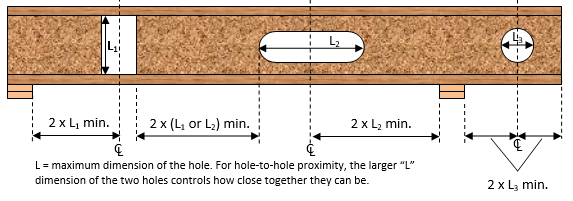
It is important to note that no holes other than manufactured knockouts can be placed in the 'no hole zone' (hatched areas) near supports as described below.
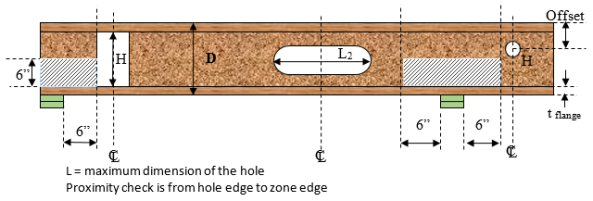
Proximity rules for round holes in TimberStrand®, Microllam®, and Parallam®
If a hole falls within the prescriptive analysis then hole proximity rules are applied as per literature. The engineered solution uses these rules:
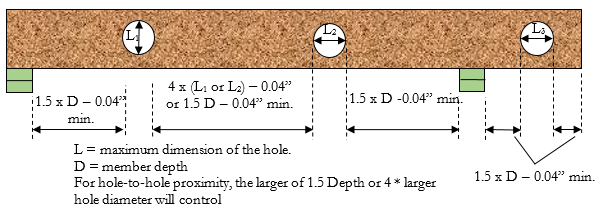
Point loads in the vicinity of holes
Point loads that are applied in the vicinity of holes are limited to certain magnitudes. If those magnitudes are exceeded then the hole will fail.
TJI®
The number of plies of TJI’s® increase the allowed point load magnitude. Likewise, point loads that are applied in the vicinity of TJI® web holes are limited by the magnitude of the uniform loads in the same vicinity. Software examines individual point loads as well as the total of all of the point loads in the vicinity of the hole.
Structural Composite Lumber
For holes in our Structural Composite Lumber, the point load magnitude is limited by the product depth instead, and is not affected by the number of plies of the member.
The figure below shows the point load vicinity for TJI® products.
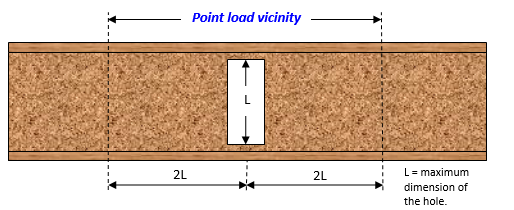
The figure below shows the point load vicinity for TimberStrand®, Microllam®, and Parallam®.
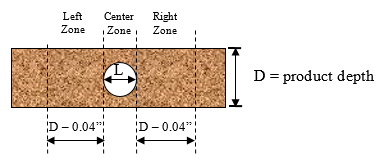
When a hole design shear and/or moment exceed the product capacity, the hole will fail. In the report holes grid, a failed hole will be tagged as failed and the row for that hole will be in a red font. Also, the graphics will show the hole with its interior color in red.
Holes too close to each other
When holes fail for the hole-to-hole proximity rule mentioned above, software will attempt to combine the holes into one hole with like dimensions and run hole analysis once more, including proximity rules. When the combined hole passes all checks, the original holes will be displayed on the output and a note below the design results will state the combined hole was successful and the holes will pass design. If the combined hole fails, the original failure will stand and a note below the design results will state the combined hole was unsuccessful, and the holes will fail design.

Ignored circular holes too close to other holes
Circular TJI holes that are defined as ignored, as per section “Number of holes per span for TJI® Products” above, are allowed to be in close proximity of any hole when a 3-inch distance from edge of hole to edge of hole is maintained.

Holes too close to support
When a hole fails for the hole too close to support proximity rule mentioned above, software will determine if the hole meets certain criteria which will reduce reaction capacity and require a web stiffener at the support, and could allow the design to pass. If the hole doesn’t meet the criteria, then the hole will continue to fail as it previously did.
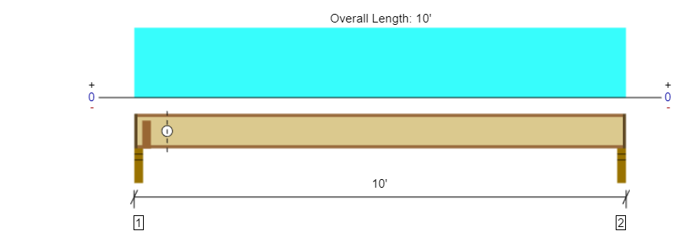
Hole Design
When a hole design shear and/or moment exceed the product capacity, the hole will fail. In the report holes grid, a failed hole will be tagged as failed and the row for that hole will be in a red font. Also, the graphics will show the hole with its interior color in red.
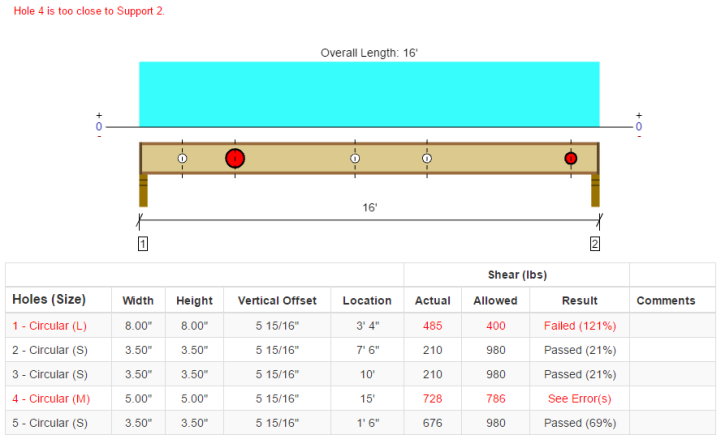
A hole may pass shear and moment checks but still fail a proximity check. In this case, the hole will also be displayed as red, a proximity constraint message in a red font will be displayed in the report’s header, and the Result column in the grid will indicate this error. The screenshot above shows the hole grid for TJI® products. For SCL products, the grid will include an additional moment check section.